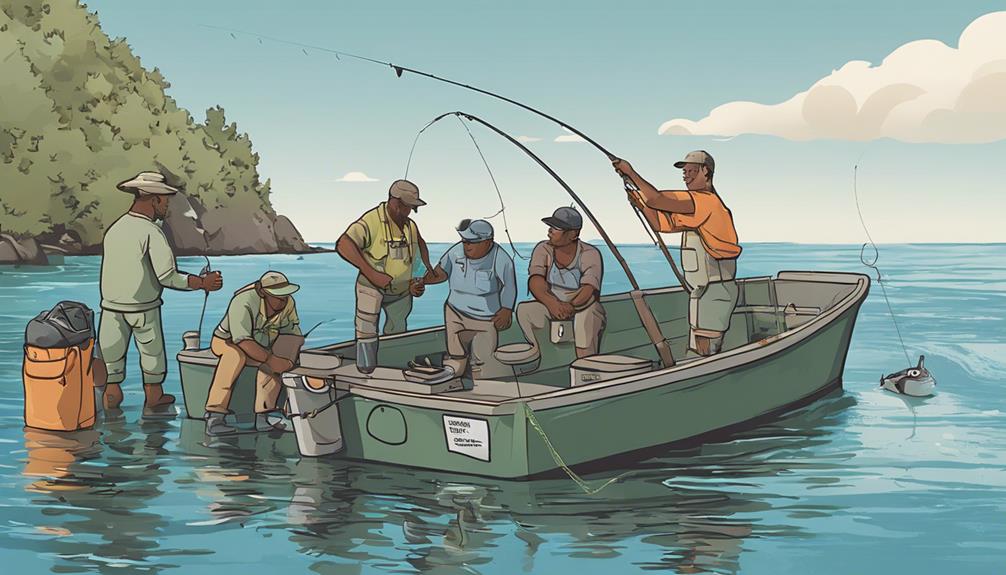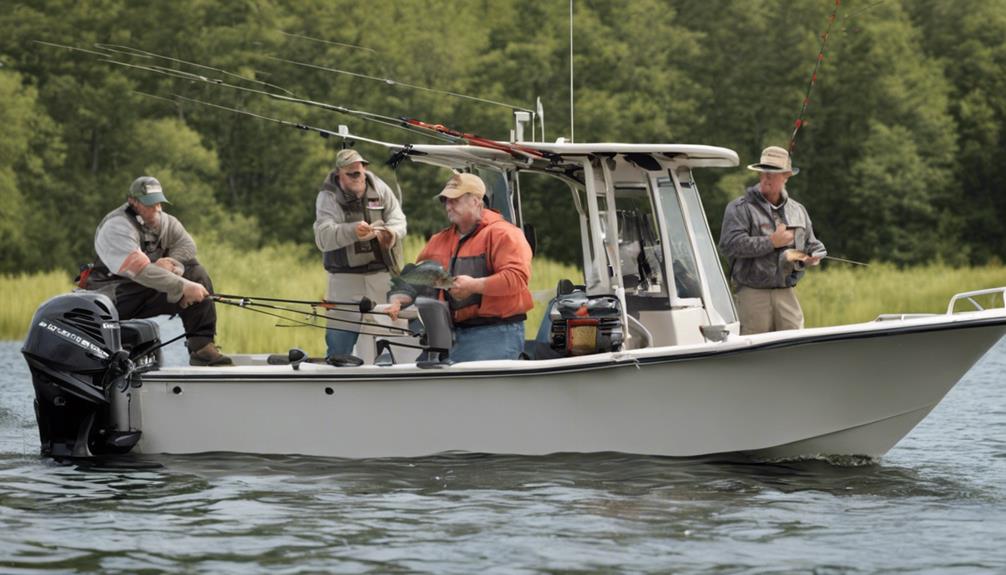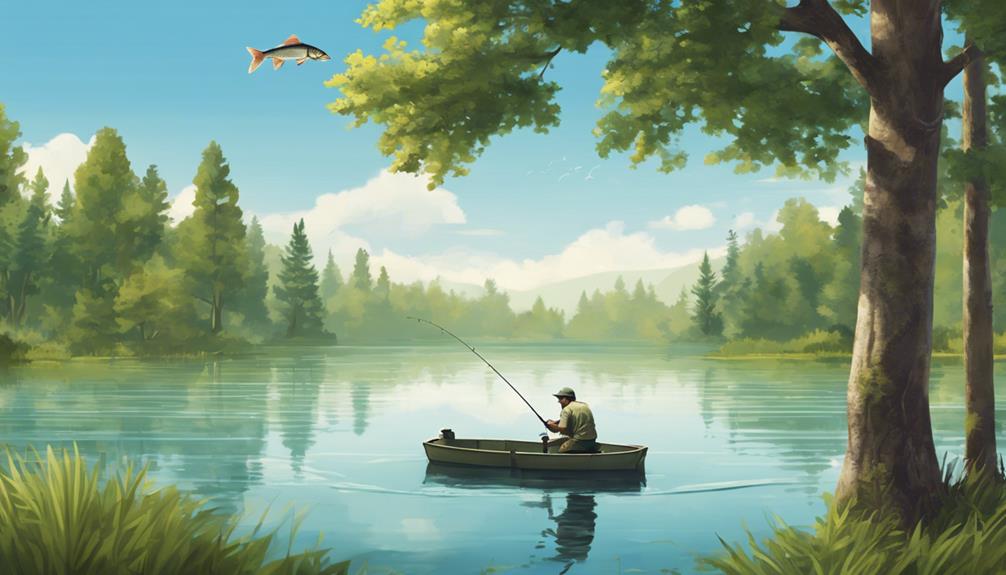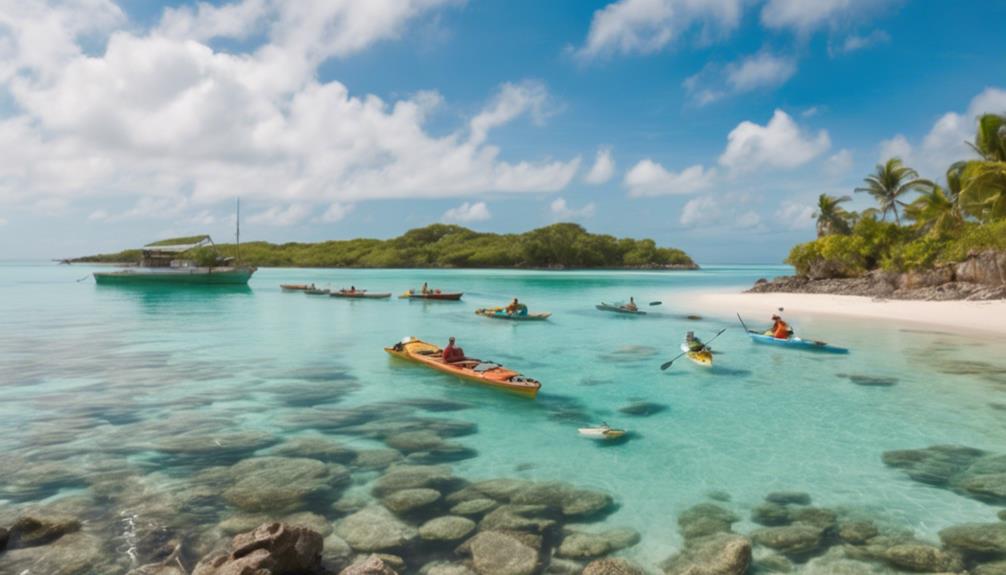Imagine marine parks as intricate ecosystems where every fishing practice can either nurture or harm the delicate balance of underwater life.
As you navigate the waters of conservation, understanding the 7 best practices for fishing in these protected areas can be a beacon of light in the vast ocean of uncertainty. Each practice serves as a cornerstone in the preservation of marine biodiversity and the sustainability of fisheries.
So, how can you become a guardian of the sea while reeling in the benefits of responsible angling practices?
Importance of Marine Park Conservation
In marine parks, preserving fish populations is crucial for maintaining the balance of the ecosystem. Marine biodiversity thrives when fish populations are kept at sustainable levels. By protecting various fish species, marine parks contribute to the overall health of the ecosystem. Ecosystem preservation is at the core of marine park conservation efforts, ensuring that all elements within the marine environment can coexist harmoniously.
When fish populations are managed effectively in marine parks, it helps prevent disruptions in the food chain. Each species plays a vital role in the ecosystem, and a decline in one population can have cascading effects on others. Through conservation measures, such as implementing fishing quotas and protected areas, marine parks safeguard the delicate balance of marine biodiversity.
Moreover, ecosystem preservation in marine parks extends beyond fish populations. It includes the protection of habitats like coral reefs, seagrass beds, and mangrove forests that serve as crucial environments for various marine species. By maintaining these habitats, marine parks support the interconnected web of life in the ocean, promoting biodiversity and resilience in the face of environmental challenges.
Sustainable Fishing Techniques
Utilizing sustainable fishing methods is essential for preserving fish populations in marine parks. By adopting practices that prioritize the long-term health of marine ecosystems, you can help ensure that these habitats remain vibrant and biodiverse for future generations.
Here are some key sustainable fishing techniques to keep in mind:
- Set catch limits: Establishing and adhering to catch limits is crucial in preventing overfishing and allowing fish populations to replenish naturally. By only taking what's sustainable, you can help maintain a balance that supports healthy marine ecosystems.
- Practice habitat protection: Protecting the habitats where fish breed, feed, and seek shelter is vital for their survival. Avoid destructive fishing methods that can damage coral reefs, seagrass beds, or other essential habitats. By safeguarding these areas, you contribute to the overall health of the marine environment.
- Use selective fishing gear: Opt for fishing gear and methods that target specific species while minimizing bycatch of non-targeted marine life. Selective gear helps reduce accidental catches of endangered species and allows for more precise and sustainable fishing practices.
Incorporating these sustainable fishing techniques into your fishing practices can play a significant role in conserving marine park ecosystems and ensuring the longevity of fish populations within them. By being mindful of catch limits, habitat protection, and gear selectivity, you actively contribute to the preservation of marine biodiversity.
Monitoring Fish Populations
To ensure the sustainability of fish populations in marine parks, continuous monitoring of their numbers and health is imperative. Fish population monitoring plays a crucial role in conservation efforts within these protected areas. By keeping a close eye on fish populations, conservationists can track changes over time, identify any declines in numbers, and take necessary actions to address potential threats.
One of the key methods used in fish population monitoring is underwater surveys conducted by trained divers or remotely operated vehicles (ROVs). These surveys help scientists estimate fish populations, determine species diversity, and assess the overall health of marine ecosystems. Additionally, advanced technologies like acoustic telemetry are utilized to track the movements and behavior of individual fish species, providing valuable insights for conservation efforts.
Conservationists also rely on data collected from fishing activities within marine parks to gauge the impact on fish populations. By analyzing catch data and monitoring fishing practices, authorities can implement sustainable fishing quotas and regulations to prevent overfishing and protect vulnerable species.
Enforcement of Fishing Regulations
Enforcing fishing regulations within marine parks is essential for ensuring the protection of fish populations and maintaining the ecological balance. Effective enforcement not only safeguards the marine ecosystem but also promotes sustainable fishing practices.
To achieve this, consider the following key points:
- Patrol Effectiveness: Regular patrols within marine parks are crucial to deter illegal fishing activities. By increasing the presence of park rangers and enforcement officers, the likelihood of detecting and preventing violations rises significantly.
- Community Engagement: Involving local communities in monitoring and reporting suspicious fishing practices can enhance enforcement efforts. Building trust and collaboration with residents living near marine parks can create a network of eyes and ears to help enforce regulations effectively.
- Technology Utilization: Leveraging technological advancements such as drones, GPS tracking, and surveillance cameras can bolster enforcement capabilities. These tools enable authorities to monitor vast marine areas more efficiently and gather evidence to support enforcement actions.
Stakeholder involvement is also paramount in the enforcement process. Engaging with various stakeholders, including fishermen, conservation groups, and government agencies, fosters a collective responsibility towards preserving marine resources. By promoting a sense of ownership and accountability among stakeholders, the enforcement of fishing regulations can be strengthened, leading to a more sustainable marine environment.
Educating Anglers on Conservation
Anglers can enhance marine conservation efforts through education on sustainable fishing practices and the importance of protecting marine ecosystems. By actively engaging in angler education and promoting conservation awareness, individuals can play a crucial role in safeguarding the delicate balance of marine life within marine parks.
Educating anglers on conservation involves raising awareness about the impact of overfishing, habitat destruction, and pollution on marine ecosystems. By understanding the repercussions of their actions, anglers can make informed decisions that contribute to the long-term health of marine environments. Conservation awareness programs can provide anglers with valuable information on catch limits, endangered species protection, and responsible fishing techniques.
Through angler education initiatives, individuals can learn how their fishing practices can either harm or help marine ecosystems. By emphasizing the importance of sustainable fishing practices such as catch and release, using biodegradable fishing gear, and respecting no-take zones, anglers can minimize their ecological footprint and promote the restoration of marine biodiversity.
Conservation awareness among anglers is essential for fostering a culture of environmental stewardship within marine parks. By instilling a sense of responsibility and respect for the marine environment, anglers can become advocates for conservation and inspire others to follow their lead. Ultimately, educating anglers on conservation is a proactive step towards ensuring the preservation of marine parks for future generations.
Collaboration With Local Communities
Working together with local communities is essential for the successful conservation of marine parks. Community engagement plays a crucial role in ensuring that conservation efforts aren't only effective but also sustainable in the long term. By collaborating with local residents, marine park authorities can tap into valuable local knowledge and foster a sense of ownership and responsibility towards the marine environment.
Key Strategies for Collaborating With Local Communities:
- Incorporating Cultural Practices: Respect for traditional cultural practices related to fishing and marine resource management is vital. By understanding and incorporating these practices into conservation strategies, marine park authorities can ensure that their efforts are culturally sensitive and inclusive.
- Establishing Communication Channels: Building strong communication channels with local communities is essential for successful collaboration. Regular dialogue, community meetings, and feedback mechanisms can help bridge any gaps in understanding and foster a sense of partnership in conservation efforts.
- Creating Economic Opportunities: Engaging local communities by creating sustainable economic opportunities linked to conservation can be mutually beneficial. Initiatives such as eco-tourism, sustainable fishing cooperatives, or community-based conservation projects can help demonstrate the economic value of preserving marine resources.
Research and Data Collection
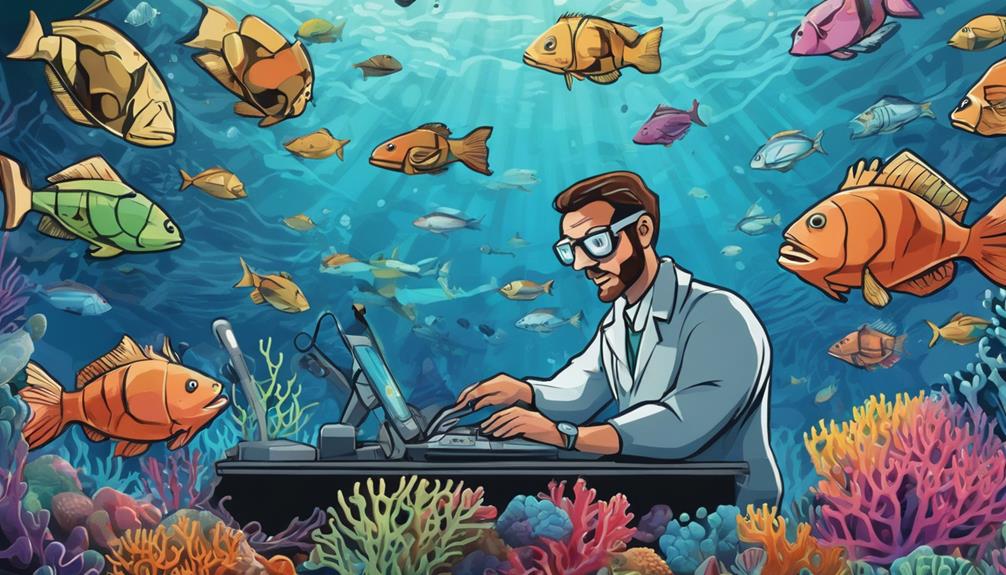
To enhance the understanding of marine ecosystems and support effective conservation efforts, conducting thorough research and data collection is imperative. Utilizing advanced sampling techniques is crucial in gathering accurate data on fish populations, habitat health, and biodiversity within marine parks. By employing methods such as underwater visual surveys, baited remote underwater video systems, and genetic analysis, researchers can obtain valuable insights into the dynamics of these ecosystems.
In addition to sampling techniques, robust data analysis is essential for extracting meaningful conclusions from the collected information. Researchers can leverage technology innovations like geographic information systems (GIS) and statistical modeling to interpret complex data sets, identify trends, and make informed decisions regarding conservation strategies. Through meticulous data analysis, marine park managers can monitor changes in key indicators, assess the effectiveness of conservation measures, and adapt management practices accordingly.
Furthermore, fostering research partnerships with academic institutions, non-profit organizations, and government agencies can enhance the scope and quality of data collection efforts. Collaborating with experts in marine biology, ecology, and conservation can bring diverse perspectives to research projects, facilitate knowledge exchange, and promote the implementation of evidence-based conservation policies. By working together, stakeholders can pool resources, share expertise, and advance our understanding of marine ecosystems, ultimately contributing to more effective fishing conservation in marine parks.
Balancing Tourism and Conservation
Finding a harmonious balance between tourism and conservation efforts in marine parks is a complex but vital endeavor. As marine parks attract visitors for their natural beauty and diverse marine life, managing tourism impact while ensuring the preservation of these ecosystems is crucial for long-term sustainability. Here are some key considerations to achieve this delicate balance:
- Visitor Education: Providing educational resources and guided tours can help raise awareness among tourists about the importance of marine conservation. By educating visitors about the fragility of marine ecosystems and the impact of human activities, they're more likely to respect and support conservation efforts.
- Sustainable Tourism Practices: Implementing regulations and guidelines for tour operators and visitors can help minimize the negative impacts of tourism on marine parks. Encouraging sustainable practices such as responsible waste disposal, limited physical interaction with marine life, and supporting local conservation initiatives can help mitigate the adverse effects of tourism.
- Community Involvement: Engaging local communities in conservation efforts can foster a sense of ownership and stewardship towards marine parks. By involving residents in decision-making processes, conservation projects, and eco-tourism initiatives, a sense of responsibility and pride in preserving their natural heritage can be cultivated.
Finding the right balance between promoting tourism and safeguarding marine ecosystems requires collaborative efforts from park authorities, visitors, and local communities. By prioritizing conservation efforts while still allowing for responsible tourism, marine parks can thrive as sustainable attractions for future generations.
Frequently Asked Questions
How Do Marine Parks Affect the Overall Health and Biodiversity of the Surrounding Marine Ecosystem?
When you explore how marine parks influence the marine ecosystem, you'll find a significant impact on marine biodiversity and overall ecosystem health. Sustainable fishing practices within these protected areas play a crucial role in promoting conservation.
What Measures Are in Place to Prevent Illegal Fishing Activities Within Marine Parks?
To prevent illegal fishing in marine parks, surveillance technology like drones and cameras is used. Enforcement strategies such as patrols and inspections are crucial.
Stakeholder engagement and community partnerships help raise awareness and encourage reporting of any suspicious activities.
How Do Marine Parks Contribute to the Protection of Endangered Fish Species?
Marine parks play a crucial role in protecting endangered species by providing safe havens where conservation efforts can thrive.
These parks benefit fish populations by creating protected areas where these species can thrive without the threat of overfishing or habitat destruction.
What Role Do Technology and Innovation Play in Monitoring and Enforcing Fishing Regulations Within Marine Parks?
When it comes to monitoring and enforcing fishing regulations in marine parks, technological advancements and innovation play crucial roles. Surveillance technologies help authorities track fishing activities, while innovative solutions enhance enforcement efforts.
How Do Marine Parks Handle Conflicts Between Conservation Efforts and the Economic Interests of Local Communities Dependent on Fishing?
When balancing marine conservation and local economic needs, marine parks address conflicts through strategic planning. They aim for sustainable solutions that support both conservation efforts and the economic sustainability of fishing communities.
By engaging with local stakeholders, marine parks can develop strategies that benefit both the environment and the livelihoods of those dependent on fishing.
Through collaboration and understanding, these parks work towards a harmonious balance between conservation and community interests.
Conclusion
In conclusion, by following these best practices for fishing conservation in marine parks, you can help protect our precious marine ecosystems for future generations.
Sustainable fishing techniques, monitoring fish populations, enforcing regulations, educating anglers, collaborating with local communities, conducting research, and balancing tourism are all key components in preserving our oceans.
Remember, every small effort counts in making a big difference in conservation efforts. Keep up the good work and continue to support marine park conservation!
